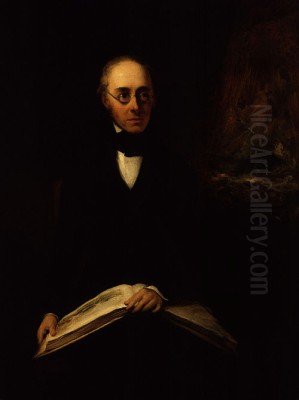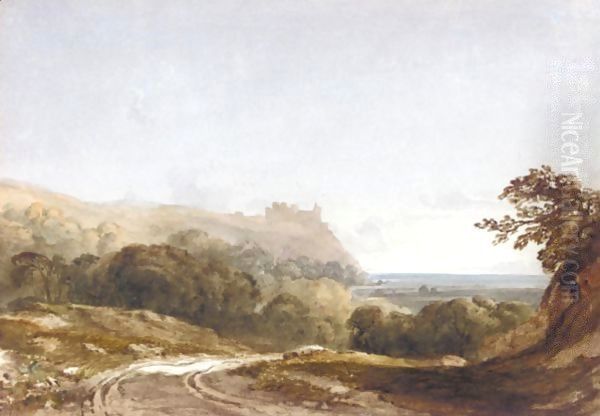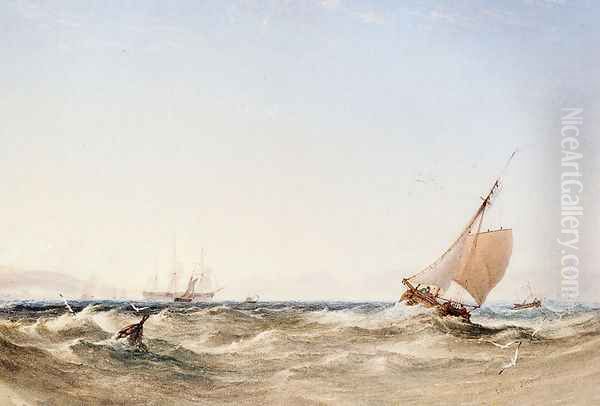
Anthony Vandyke Copley Fielding stands as a significant figure in the golden age of English watercolour painting. Born on November 22, 1787, and passing away on March 3, 1855, his life spanned a period of immense artistic innovation and change in Britain. Known primarily for his evocative landscapes and seascapes, Fielding achieved considerable fame and influence during his lifetime, becoming a leading member and eventually President of the prestigious Society of Painters in Water Colours. His work, characterized by its atmospheric effects and technical proficiency, captured the subtle beauties of the British countryside and coastline, securing his place in the annals of art history.
Early Life and Artistic Formation
Born in Sowerby Bridge, near Halifax in the West Riding of Yorkshire, Anthony Vandyke Copley Fielding (often known simply as Copley Fielding) was immersed in an artistic environment from birth. He was the second son of Nathan Theodore Fielding, a portrait painter of modest reputation who moved his family frequently in pursuit of commissions. This peripatetic early life exposed the young Fielding to diverse landscapes across England. His distinctive name, combining references to the great Flemish portraitist Sir Anthony van Dyck and the American painter John Singleton Copley, perhaps hinted at his parents' artistic aspirations for him.
Artistic talent ran strongly in the Fielding family. Copley Fielding and several of his brothers – Theodore Henry Adolphus Fielding, Thales Fielding, and Newton Smith Fielding – all pursued careers as painters and engravers, forming a notable artistic dynasty. Initial instruction naturally came from their father, providing a foundational understanding of drawing and painting techniques. The family eventually settled in London, offering greater access to the burgeoning art scene and educational opportunities.

A pivotal moment in Copley Fielding's development came when he entered the studio of John Varley around 1807 or 1808. Varley was not only a highly respected watercolourist but also an influential and charismatic teacher whose pupils included some of the most significant figures of the next generation of landscape painters, such as David Cox, William Turner of Oxford, John Linnell, and William Henry Hunt. Under Varley's tutelage, Fielding honed his skills in watercolour, learning compositional strategies and techniques for capturing light and atmosphere, elements that would become hallmarks of his mature style.
In 1809 or 1810, Fielding furthered his formal education by enrolling as a student at the Royal Academy Schools, although his primary dedication remained watercolour. The Royal Academy, dominated by oil painting and historical subjects under figures like Sir Thomas Lawrence, provided exposure to the highest echelons of the London art world, but the burgeoning medium of watercolour found its main champion elsewhere. It was within the specialized societies dedicated to watercolour that Fielding would truly make his mark.
The Society of Painters in Water Colours
The early 19th century witnessed a remarkable rise in the status and popularity of watercolour painting in Britain. Previously often regarded as a medium primarily for preparatory sketches or topographical records, artists began to explore its full expressive potential, creating finished exhibition pieces that rivaled oils in scale and ambition. Central to this elevation was the Society of Painters in Water Colours (SPWC), founded in 1804. Often referred to as the "Old" Water-Colour Society (OWCS) after a rival society emerged, it provided a crucial platform for artists working in the medium.
Copley Fielding's association with the Society began early in his career. He started exhibiting there in 1810, showcasing views of Wales and the Lake District, regions whose dramatic scenery perfectly suited the Romantic sensibilities of the time. His talent was quickly recognized, and he was elected an Associate Exhibitor in 1810 and a full Member in 1812 or 1813 (sources vary slightly on the exact dates). This rapid ascent within the Society's ranks indicated his growing reputation among his peers.
Fielding became one of the Society's most prolific and consistent exhibitors. For over four decades, his works were a mainstay of the annual exhibitions, eagerly anticipated by patrons and the public. His contributions were numerous; records suggest he exhibited over 1,700 works at the Society's exhibitions alone throughout his career, alongside contributions to the Royal Academy and the British Institution. This remarkable output speaks to his dedication, facility, and the considerable demand for his work.

His commitment to the Society extended beyond exhibiting. He served as Treasurer from 1813 and Secretary from 1815. His standing within the group culminated in his election as President in 1831, a position he held with distinction until his death in 1855. His long presidency provided stability and leadership during a period of continued growth and consolidation for the Society (which received its Royal Charter in 1881, becoming the Royal Society of Painters in Water Colours, or RWS). His contemporaries within the society included luminaries like David Cox, Peter De Wint, Samuel Prout, and later figures he helped nurture.
Artistic Style and Subject Matter
Copley Fielding developed a distinctive and highly influential watercolour style. While grounded in the topographical tradition learned partly from Varley, he imbued his landscapes with a powerful sense of atmosphere, light, and weather. He excelled at rendering the vast, open spaces of the British landscape – rolling hills, expansive moors, dramatic coastlines, and turbulent seas. His work often captures fleeting moments: the gleam of sunlight breaking through clouds after a storm, the misty haze of early morning, or the dramatic glow of sunset.
His technique was characterized by broad, fluid washes of transparent colour, skillfully layered to create subtle gradations of tone and hue. He was a master of suggesting distance and aerial perspective, making his landscapes feel deep and immersive. While often favouring soft, diffused light, he could also depict dramatic chiaroscuro effects, particularly in his storm scenes at sea. Unlike the detailed, sometimes meticulous approach of earlier watercolourists, Fielding often prioritized overall effect and mood over precise rendering of detail, aligning him with the broader Romantic movement's emphasis on emotion and the sublime power of nature.
Early in his career, Fielding frequently depicted the landscapes of North Wales and the Lake District, areas popularized by the first generation of Romantic travellers and artists. His views of Snowdonia, Derwentwater, and Ullswater captured the rugged grandeur and picturesque beauty of these regions. He later became particularly associated with the scenery of the South Downs in Sussex, near Brighton and Worthing where he eventually settled. He rendered the undulating chalk hills and wide skies of the Downs with particular sensitivity, capturing their unique quality of light and space.
Marine painting became an increasingly important part of his output, especially later in his career. He produced numerous studies of shipping, coastal scenes, and dramatic storms at sea. These works showcased his ability to render the movement of water and the dynamic interplay of sea and sky. His seascapes were highly sought after, admired for their energy and atmospheric truthfulness. While primarily a watercolourist, Fielding also worked occasionally in oils, exhibiting oil paintings at the Royal Academy and the British Institution, though it is his watercolours that form the core of his artistic legacy.
An influence often noted in Fielding's work, particularly in his compositional structures and idealized approach to landscape, is the 17th-century Franco-Italian painter Claude Lorrain. Like Claude, Fielding often used framing devices like trees and carefully balanced masses of light and shadow to create harmonious, picturesque views. However, Fielding's work remained firmly rooted in the specific observation of British scenery and weather effects.
Key Works and Recognition
While Copley Fielding produced a vast number of works, several stand out as representative of his style and achievements. His depictions of the South Downs, such as The South Downs Landscape, exemplify his ability to capture the expansive, rolling character of that region, often under vast, cloud-filled skies. These works convey a sense of tranquility and timelessness, rendered with his characteristic soft light and atmospheric haze.
His paintings of mountainous regions, like Harlech Castle, combine topographical accuracy with romantic sensibility. The ancient castle is often shown nestled within or dominating a dramatic landscape, emphasizing the interplay between human history and the enduring power of nature. Such works appealed strongly to the contemporary taste for the picturesque and the historical.
Sunset Over Loch Lubnaig is another example showcasing his mastery of light and atmosphere. Works depicting sunset or sunrise allowed Fielding to explore dramatic colour palettes and transient light effects, bathing the landscape in warm, evocative glows. These paintings highlight his skill in manipulating watercolour washes to achieve luminosity and depth.
His marine subjects, often simply titled Off the Coast or depicting specific locations like the Needles, were equally popular. View Down The River Wye Towards Chepstow Castle demonstrates his ability to integrate architectural elements within a broader river landscape, a common theme in British picturesque art. His storm scenes at sea captured the drama and danger of maritime life, resonating with Britain's identity as a seafaring nation.
Fielding's reputation extended beyond Britain. A significant moment of international recognition came at the Paris Salon of 1824. This exhibition was a landmark event, showcasing British landscape painting to a French audience and critics. Fielding exhibited alongside compatriots John Constable and Sir Thomas Lawrence. His watercolours, along with those of Richard Parkes Bonington (who worked extensively in France but was British-born), received high praise and were awarded a gold medal by King Charles X.
This success in Paris was particularly noteworthy. French artists and critics, including the great Romantic painter Eugène Delacroix, were deeply impressed by the freshness, naturalism, and atmospheric qualities of the British landscapes, particularly the work of Constable and Bonington. Fielding shared in this acclaim, and Delacroix himself is known to have admired Fielding's work, recognizing his technical skill and sensitivity to nature. This event helped to stimulate the development of landscape painting in France and cemented the international reputation of the British school.
Teaching and Influence
Beyond his own prolific output, Copley Fielding was a highly sought-after and influential teacher. His success as an artist, combined with his prominent position in the Old Water-Colour Society, made him a desirable instructor for aspiring professionals and wealthy amateurs alike. He commanded high fees for his lessons, reflecting the strong demand for instruction in the fashionable art of watercolour painting. His contemporaries sometimes referred to him informally as a "professor" due to his teaching activities.
His teaching methods likely emphasized the techniques he employed in his own work: mastering fluid washes, understanding tonal values, and capturing atmospheric effects. He encouraged direct observation of nature, undertaking sketching tours himself, often described as an "idle, travelling painter," although his output suggests considerable industry. His Brighton residence became a centre for his teaching activities later in his life.
One notable student who benefited from Fielding's guidance was Conrad Martens. Martens studied with Fielding around 1832 before embarking on his voyages, including his time as official artist aboard HMS Beagle (after Augustus Earle fell ill), where he worked alongside Charles Darwin. Martens' subsequent work in South America and Australia shows clear evidence of Fielding's stylistic influence, particularly in the handling of light and atmosphere in his watercolour landscapes.
Fielding's broader influence extended through his widely exhibited works and his leadership role in the OWCS. His popular style, which balanced picturesque conventions with convincing natural effects, set a standard for landscape watercolour for much of the mid-19th century. While perhaps less revolutionary than contemporaries like J.M.W. Turner or John Constable, Fielding's consistent quality, technical mastery, and appealing subject matter made his work highly influential and widely imitated. He represented the mainstream excellence of the English watercolour school.
Later Life and Legacy
Copley Fielding enjoyed sustained success throughout his career. The demand for his watercolours remained high, providing him with a comfortable income. Around 1829, he moved from London to Brighton, and later settled in nearby Worthing, although he maintained connections with the London art world, particularly through his presidency of the OWCS. The coastal scenery of Sussex provided ample inspiration for his later marine paintings and views of the South Downs.
He continued to paint and exhibit prolifically into his later years. His dedication to the Society of Painters in Water Colours remained unwavering, presiding over its affairs until the end. His long tenure as President provided continuity and helped maintain the Society's high standards and public profile.
Anthony Vandyke Copley Fielding died at his home in Worthing, Sussex, on March 3, 1855, at the age of 67. He was buried in the churchyard of St Andrew's Church, Hove (now part of Brighton and Hove). A marble tablet commemorating his life and achievements was erected inside the church, testament to the high regard in which he was held.
His legacy lies primarily in his contribution to the English watercolour tradition. He was a consummate master of the medium, demonstrating its capacity for capturing subtle atmospheric effects and the diverse moods of the British landscape and seascape. His works were admired for their elegance, refinement, and technical brilliance. While perhaps lacking the visionary intensity of Turner or the groundbreaking naturalism of Constable, Fielding represented the pinnacle of accomplishment within the established picturesque and Romantic landscape conventions of his time.
Critical Reception and Historical Perspective
During his lifetime, Copley Fielding was immensely popular and critically acclaimed. His works consistently sold well, and his position as President of the OWCS reflected the esteem of his peers. Critics praised his handling of light, his atmospheric effects, and the sheer beauty and technical accomplishment of his watercolours. The gold medal at the 1824 Paris Salon further solidified his reputation both at home and abroad. He was seen as a leading exponent of a uniquely English art form.
However, later critical assessments, particularly from the late 19th and 20th centuries, have sometimes been more qualified. Some critics, like the influential John Ruskin (though Ruskin also found things to praise), felt his work could be repetitive or formulaic, lacking the profound emotional depth or innovative vision of the greatest landscape masters. There was a sense that his immense facility sometimes led to a certain superficiality, a tendency to rely on pleasing effects rather than rigorous observation or deep engagement with the subject. His vast output inevitably included works of varying quality.
Despite these criticisms, Fielding's historical importance remains undeniable. He played a crucial role in the development and popularization of watercolour painting in Britain. His technical mastery set a high standard, and his influence on subsequent generations of watercolourists, both professional and amateur, was significant. His works perfectly captured the prevailing taste for picturesque and Romantic landscapes, offering elegant and atmospheric interpretations of British scenery.
Today, his watercolours are held in major public collections worldwide, including the Victoria and Albert Museum, the British Museum, Tate Britain, and numerous regional galleries in the UK, as well as museums in the United States and elsewhere. His works continue to be appreciated for their technical skill, their evocative rendering of atmosphere, and their quintessential representation of the 19th-century British landscape aesthetic. Auction results for his major works confirm his enduring appeal to collectors.
Conclusion
Anthony Vandyke Copley Fielding was a central figure in the golden age of English watercolour. Born into an artistic family and trained by the influential John Varley, he rose rapidly through the ranks of the Society of Painters in Water Colours to become its long-serving President. His prolific output, characterized by masterful technique, atmospheric sensitivity, and a focus on the landscapes and seascapes of Britain, earned him widespread acclaim and commercial success during his lifetime.
While perhaps not possessing the revolutionary vision of some of his contemporaries, Fielding's consistent excellence, his influential role as a teacher, and his leadership within the watercolour society cemented his importance. He perfected a style that captured the subtle beauties of light, weather, and place, resonating deeply with the Romantic sensibilities of his era. His legacy endures in his numerous, often beautiful watercolours, which remain a testament to his skill and a significant contribution to the rich history of British art.